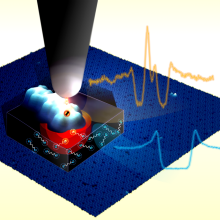We investigated the evolution of a Yu-Shiba-Rusinov state, using a molecular magnetic center deposited on superconducting Pb islands. This work is a European collaboration of the Loth group (Hamburg and Stuttgart, Germany), the Sessolir group (Florence, Italy) and the Soleil synchrotron (Gif-sur-Yvette, France).
Single magnetic centers in close proximity with superconducting surfaces give rise to rich physics, which is attracting a growing interest in the scientific community, with possible applications in the emerging field of quantum technology. Indeed, a superconductor can act as a resonator, generating photons that, by coupling with spin centers near the superconductor, allows for coherent control of quantum states. In these experiments, the key ingredient is the interaction of the spin centers with the photons, which generate entangled spin-photon states. Additional interactions, such as those between the magnetic centers and the electrons of the superconductor, usually observed for spin centers in direct contact with the superconducting surface, reduce the coherence time of the quantum state. However, this specific interaction results in new states, named Yu-Shiba-Rusinov bound states, after the scientists who first posited their existence. In particular circumstances, these states lead to the appearance of Majorana quasiparticles; they resemble the fermionic particles that are also their own antiparticle, postulated by Majorana almost 80 years ago. These states are extremely interesting for quantum technology applications, and an increasing number of groups around the world are studying them. The appearance of both Yu-Shiba-Rusinov and Majorana bound states can be observed in scanning tunneling microscopy experiments via conductance measurements.
The molecules used in our work are vanadyl phthalocyanine, which have seen applications as molecular quantum bits, and have even been addressed in superconducting resonators. The molecules are somewhat flat, and analogous to a coin can be either “heads” or “tails” on the surface. In one of these positions the magnetic center is interacting with the surface, giving rise to a Yu-Shiba-Rusinov state, while in the other it is more isolated from it. By effectively “squishing” the latter using a scanning tunneling microscope we were able to both induce and control the Yu-Shiba-Rusinov state which emerges. The degree of control, from isolated to interacting, gives an effective “knob” to turn for the control of superconductor-spin interaction. Moreover, the molecule provides a promising platform for superconducting resonator applications, due to its unique feature of being very close to a superconductor, yet not interacting with it, and in turn maximizing spin-photon interaction.
The paper is titled "Tunable Spin-Superconductor Coupling of Spin ½ Vanadyl-Phthalocyanine Molecules" and just appeared in Nano Letters.
The full author list is:
Luigi Malavolti,*, †§‡ Matteo Briganti, ¥ Max Hänze, †§‡ Giulia Serrano, ¥ Irene Cimatti, ¥ Gregory McMurtrie, †§‡ Edwige Otero, ^ Philippe Ohresser,^ Federico Totti, *, ¥ Matteo Mannini, ¥ Roberta Sessoli, ¥ and Sebastian Loth*, †§‡
† Institute for Functional Matter and Quantum Technologies, University of Stuttgart, 70569 Stuttgart, Germany
§ Max Planck Institute for the Structure and Dynamics of Matter, 22761 Hamburg, Germany
‡ Max Planck Institute for Solid State Research, 70569 Stuttgart, Germany
¥ Dipartimento di Chimica “Ugo Schiff” & INSTM RU, Università degli Studi di Firenze, Via della Lastruccia 3-13, 150019 Sesto Fiorentino (Firenze), Italy
^ Synchrotron SOLEIL, 4891192 Gif-sur-Yvette, France


